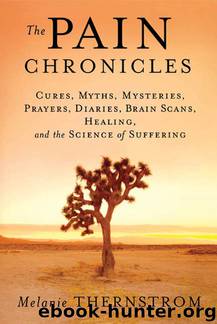The Pain Chronicles: Cures, Myths, Mysteries, Prayers, Diaries, Brain Scans, Healing, and the Science of Suffering by Melanie Thernstrom

Author:Melanie Thernstrom [Melanie Thernstrom]
Language: eng
Format: epub, mobi
Tags: Self-Help
ISBN: 9780865476813
Publisher: Macmillan
Published: 2010-08-15T07:00:00+00:00
What about humans? Work done by Dr. A. Vania Apkarian at Northwestern University found that chronic pain causes degeneration in parts of the human brain in a way that he speculates is due to “overuse atrophy”—death of neurons owing to excitotoxicity and inflammatory agents (as had been previously found in the spinal cord). He also found that chronic pain appears to diminish cognitive abilities and interfere with parts of the brain (specifically areas of the prefrontal cortex) that are involved in making emotional assessments, including decision making, and in controlling social behavior.
One of Dr. Apkarian’s studies contrasted brain images of normal subjects with those of twenty-six patients who had suffered from unrelenting chronic back pain for more than a year (with the typical pain patient having had pain for five years). Back pain is the most common pain syndrome next to headache: a quarter or more of Americans report suffering from back pain in the prior three months, and for a quarter of those, the pain becomes severe and chronic. The scans revealed that chronic pain had dramatically reduced the gray matter of the patients’ brains. (The amount of gray matter in certain areas of the brain is correlated with intelligence; it contains neurons that process information and store memory.) While normal aging causes gray matter to atrophy by half a percent a year, the gray matter of chronic pain patients atrophies dramatically faster: the pain patients showed losses amounting to between 5 and 11 percent, the equivalent often to twenty years of aging.
Normal aging processes differ from the process associated with chronic pain, in a particularly disturbing way. Where aging causes atrophy in many regions of the brain, chronic pain specifically atrophies those parts of the brain whose job is to modulate pain (the thalamus and parts of the prefrontal cortex). Both neuropathic and inflammatory pain were associated with decreases in gray matter density, but neuropathic pain had a distinct and much greater impact on the brain. The loss in brain density seemed related to pain duration, with 1.3 cubic centimeters of gray matter being lost for every year of chronic pain. When asked, Dr. Apkarian estimated that the chronic pain patients would lose roughly twice as much gray matter per year as the normal subjects.
Here, finally, I realized, is the secret of the chronic pain cycle, why it worsens over time without new nerve or tissue damage: pain causes changes in the brain that diminish the parts of the brain charged with modulating pain, which results in an increase in pain, which further atrophies the brain . . . and so forth. “As atrophy of elements of the circuitry [of the brain] progresses, the pain condition becomes more irreversible and less responsive to therapy,” the study ominously concluded.
If my own brain had lost 1.3 cubic centimeters of its gray matter for each year I had pain, then it would have lost . . . what percent by now? How many extra years had pain aged my brain? The
Download
The Pain Chronicles: Cures, Myths, Mysteries, Prayers, Diaries, Brain Scans, Healing, and the Science of Suffering by Melanie Thernstrom.mobi
This site does not store any files on its server. We only index and link to content provided by other sites. Please contact the content providers to delete copyright contents if any and email us, we'll remove relevant links or contents immediately.
Men In Love by Nancy Friday(4390)
Everything Happens for a Reason by Kate Bowler(4094)
The Immortal Life of Henrietta Lacks by Rebecca Skloot(3863)
Why We Sleep by Matthew Walker(3818)
The Sports Rules Book by Human Kinetics(3633)
Not a Diet Book by James Smith(2777)
The Emperor of All Maladies: A Biography of Cancer by Siddhartha Mukherjee(2467)
Sapiens and Homo Deus by Yuval Noah Harari(2450)
Day by Elie Wiesel(2270)
Endless Forms Most Beautiful by Sean B. Carroll(2106)
Angels in America by Tony Kushner(2078)
A Burst of Light by Audre Lorde(2003)
Hashimoto's Protocol by Izabella Wentz PharmD(1925)
Dirty Genes by Ben Lynch(1883)
Reservoir 13 by Jon McGregor(1876)
Stretching to Stay Young by Jessica Matthews(1732)
Fat for Fuel by Joseph Mercola(1720)
The Immune System Recovery Plan by Susan Blum(1719)
Boost Your Brain Power in 60 Seconds by Michelle Schoffro Cook(1695)
